Olle Skratthult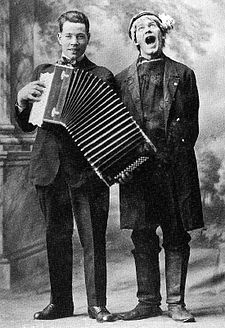
In the category of "famous visitors to Stromsburg" the name of Olle i Skratthult must be mentioned. This Swedish-American commedian, whose stage name is translated "Olle of Laughingwoods," was widely known in the immigrant communities and toured widely with his entourage including his wife, a musician.
In November of 1917 he announced one of two appearances known at the Opera House in Stromsburg, no doubt to as appreciative an audience as might be found. One can only imagine the "inside jokes" and word plays that might delight the immigrants but be wholly lost on the rest of us. Martin Jones once shared with me his collection of 78 rpm records which may have included Olle doing a routine. If this memory is accurate, the commedian was laughing himself breathless as he delivered his lines.
Humor is a great medicine, and for people suspended between two cultures and languages there are surely many occasions for amusement. In church, for instance, when pastor urged the members in Swedish to "turn their eyes to the cross" he would have said "korset" for cross. Imagine how this would have sounded to the English-speaking youngsters! It is encouraging to know that our forebears were able to laugh at themselves.
Part of the Olle i Skratthult legend involves an appearance he made in a Minnesota locale. During his performance one old Swede laughed so hard that he passed out and could not be revived. This may be why Olle refrained from using the phrase "you'll die laughing" in his advertisements.
-Dalakarl
.................................
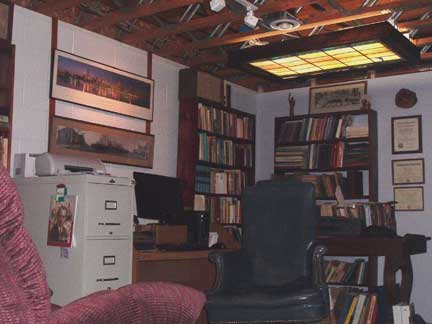
The Dalakarl Office
There is special meaning in these volumes, as they were printed in English by Swedish-speaking fellowships who were very concerned about losing the "next generation" because of the language issue. Some people seem to have the natural ability to use two languages, that is to be bilingual, but most including me do not. Those who had this skill in the immigrant communities rose to leadership in both the secular and religious spheres. I suspect this is true of any ethnic group.
Was David Nelson a Sunday School teacher in the York Bethesda church? Was he related to John Nelson, my grandmother's uncle who lived in York? One would love to know. Quite a number of the books now in my care and keeping have inscriptions like these. My Church editions are hardbound and with many glossy photographs. One is of the Augustana seminary students of 1866 which includes J.G. Princell, who later went on to be one of the founders of the Swedish Free Mission denomination. I am straining my eyes to see if Rev. C.A. Falk of Stromsburg appears in a later such picture; we know he studied there.
Though going to great effort to produce material readable in the language of the younger generation, there are some awkward phrases. And though the language is new, the content is often very "preachy" just as it would have been were it written in Swedish.
The third book is Historical Sketch: First Methodist Episcopal Church, Stromsburg Nebr. by Mrs. Florence Donelson-Haverland, "read at the laying of the cornerstone of the church, July fourth, nineteen hundred and twenty," and published by the Record Publishing Co., Osceola, Nebr. (the library now has the 1984 centennial history of our Methodist church by Sylvia Torell and Eleanor Hatfield on CD in Adobe format)
Thanks to all of the above for helping keep our wonderful traditions alive!
-Dalakarl
...................................
In 1921 our new druggist from Dannebrog, H. Christensen, placed an ad for music lovers. These were Brunswick records; "no doubt you have been looking for some of these very numbers." See if you recognize any of these real oldies.
Beautiful Faces, Castle of Dreams, Home Again Blues, I Love You Sunday, National Emblem March, Avalon, Kismet, Beale Street Blues, Kiss-a-Miss, Hula Blues, Rosie, Feather Your Nest, June, Ole Uncle Moon, My Old Kentucky Home, I Love You Truly, Kathleen Mavourneen, All Through the Night, Sing Me to Sleep, Some Blessed Day, In the Gloaming and Church in the Wildwood. Not too many survivors from that list. "Glad to play any record for you," says Chris.
While listening, you might want to read one of the magazines from Christensen's news stand. Here are some of the titles:
All-Story, American, Adventure, Blue Book, Bill Board, Colliers Weekly, Cosmopolitan, Deliniator, Designer, Elite Styles, Farm and Fireside, Film Fun, Green Book, Harpers Bazaar, Hearsts, House and Garden, Hunter Trade and Trapper, Literary Digest, Live Stories, Ladies Home Journal, Motor, McCall, Modern Priscilla, Motion Picture Magazine, McClures and National Geographic. Just to make sure you don't miss an issue, Chris will "also take subscription for any magazine."
To quote a line from an old song: "Deary, if you remember, then deary you're much older than I."
-Dalakarl
......................................
Grieving for You, Just Snap Your Fingers at Care, Margie, Jinga-Bula-Jing-Jing, Jack Tar March, Change Your Name, Happy, St. Louis Blues, Singin' the Blues, Hop-Skip and Jump, Caresses, All She'd Say was "Uhm-Hum," Treasure Isle, Lucky Jim, Sweet Genevieve, Long Long Ago, Killarney, Auld Lang Syne, Sweetest Story Ever Told, Sometime Somewhere, Silver Threads Among the Gold and The Wayside Cross. These were Brunswick records, I wonder if their bowling balls were made from the same material?
We're not done with the magazines either. How about National Sportsman, Outdoor Life, Peoples Magazine, Peoples Home Journal, Photo Play, Picture Play, Popular Mechanics, Popular Science, Pictorial Review, Red Book, Review of Reviews, Short Stories, System, Good Housekeeping, Physical Culture, True Story, Saturday Evening Post, Telling Tales, Top Notch, Today's Housewife, Western Stories, Worlds Work and Womans Home Companion.
Wonder if you could get Police Gazette from behind the counter?
-Dalakarl
.................................
Trains, automobiles and even airplanes are a known quantity to readers of the 1921 Headlight, but here is a piece that is an eye-opener:
"To sit and listen in your own home...to the strains of a symphony orchestra in Lincoln, as plain as you were there, is the treat that the F.E. Halden family are in position to enjoy. His son, Carl, has a very perfect wireless and with an amplifier, or whatever it is termed, music or lectures can be heard, from any location within the radius of the apparatus We suppose that Karl Nyquist and Leo Carlson have the same privilege as both have installed wireless apparatus at their respective homes."
"whatever it is termed..."; notice the word "radio" does not yet appear. How times have changed! Imagine what editor Chattie Coleman might say about television or computers!
-Dalakarl
One of these revealed that what a certain venerable immigrant lady missed most about Sweden were the frequent outdoor dances held on a wooden floor at the edge of the village, with accordian music, waltzes and polkas. I know for a fact that this lady's descendants for the most part would not approve of such activities!
Like Lee, I have always been fascinated with stories of the second world war. It was amazing to find from another of these interviews that a gentleman who today is often encountered at the post office was command pilot of a bomber escorted by the famous Tuskegee Airmen, and who lost one of the planes in his formation to an attack by Luftwaffe jet fighters. Their attack was so swift that he did not even see them, but his gunners did.

The Me-262 in miniature
Colorful events from the past are often closer to us than we might think, and the library is a wonderful place to find them.
-Dalakarl
...........................
In the days when C.H. Morrill occupied the log house on his homestead/estate there was no more fascinating place around. Never was this more true than in 1924, when Mr. Morrill entertained the entire Lincoln Kiwanis Club there. The newspaper reported cars parked up and down the road and nearly six hundred visitors who were fed by their gracious host from this fanciful menu:
Fish, a la Blue River; roast Texas ox, a la cement; roast home grown elk, a la "hair on;" spuds, a la cartfull; fried chicken, a la Plymouth Rock; baked beans, a la Boston; ice cream, a la "cake walk;" lemonade, a la "spiritus frumenti (nit);" cider, a la still in the cellar; Kiwanis nuts from Lincoln; cigars, a la Bobbie Burns...
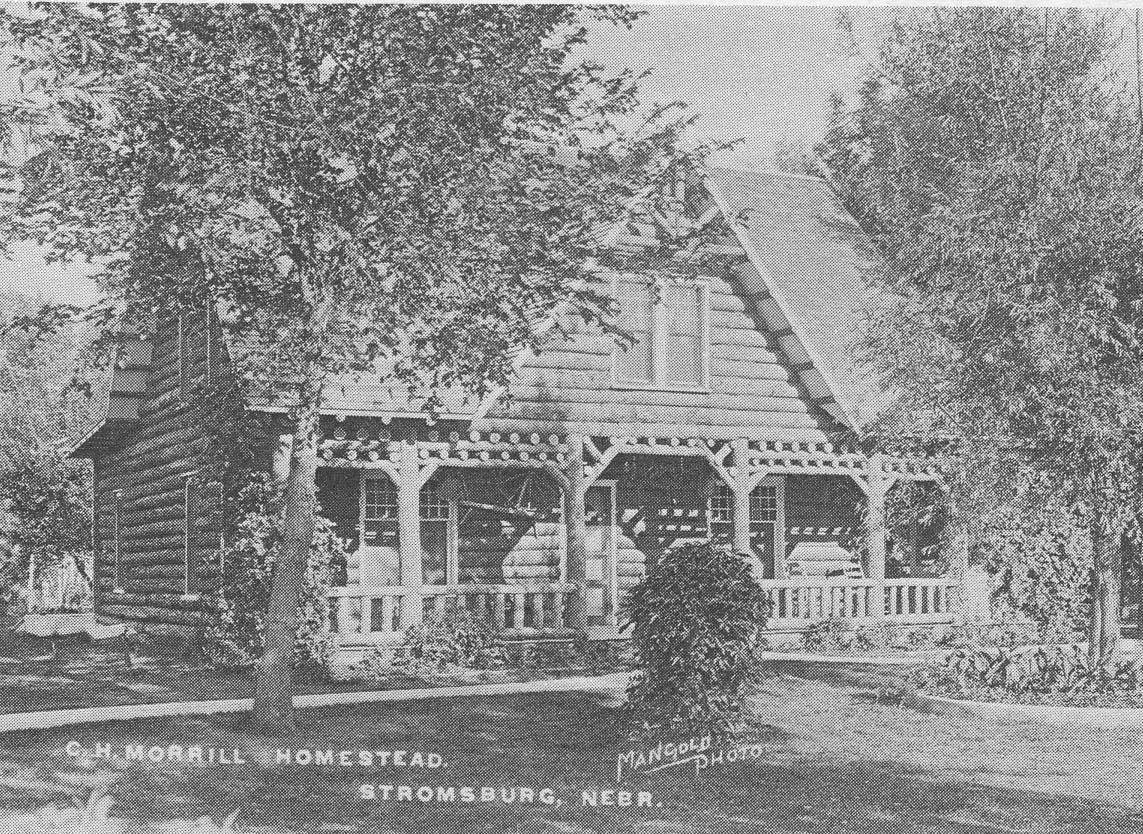
The Morrill log house
The report goes on; "Of course one must see the place to begin to appreciate what this grand old pioneer has done to make a prairie farmhome look like the suburbs of paradise..." It must have been a grand day. If you should view the DVD at the library on the Morrill place given by the Bakers, you can what might be an example of that "cider a la still in the cellar."
On another occasion, Morrill hosted a gala event for his grandchildren and once again produced a humorous breakfast menu for his guests. "Home grown grape fruit, a la elm trees; Toast, a la corn meal mush; crisp bacon, a la fried pigs tails; soft-boiled rooster eggs; French coffee made in Sweden; soup, a la 'silver lining.' The 'soup,' contrary to custom was the last on the menu and was served only to the honored guests, and consisted of ten dollars in small silver change in each bowl over which had been poured milk and crackers."
-Dalakarl
...........................
In 1924 a professional survey of Stromsburg was conducted (Headlight, 9-11-24) with some interesting findings:
"From a religious standpoint the following was learned. Stromsburg has a church enrollment of fifteen hundred and nine, with only four hundred and twenty-eight living in the town, the remaining members from the country. The membership in town is only 31.5% of the population. During the last year the eight churches have added eighty-six members, fifty-four by confession of faith, the remainder from other church organizations. The total gain was only twenty-five as two churches lost in membership. There are fifteen organizations for women and girls, two for men and none for boys alone. The estimated value of the church property in Stromsburg is $142,800 with a further valuation of $40,500 for parsonages.
Last year the churches spent a total of $34,816, with the average dollar of this amount divided as follows: Benevolences .41, pastor's salary .345, general maintenance .16, repairs .055, all other expenses .03. One church gave 70 cents of each dollar for benevolences. During the last year the churches supported nine workers in foreign fields. In ten years five persons have gone from all the churches into active professional Christian service.
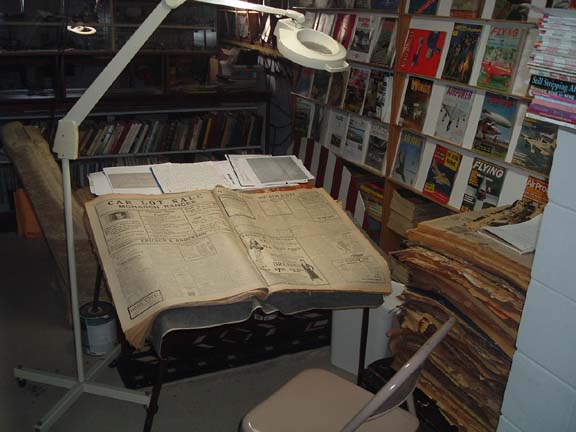
The Dalakarl reading room
The Swedish people are a churchly class: they attend their services more regularly than do the average American. In their gifts they are exceptionally liberal in the giving to Missionary causes. The gentlemen stated as their opinion that the church life in the community could be made more effective if several of the churches would federate; the two Mission churches by uniting would become a greater power in the community as well as the American and Swedish Baptist churches.
Another statement made was that the entire community needs a different system of religious education, as many young people are losing their interest in the church, one reason for this is the fact that in school they are under trained teachers, but in the Sunday school the teachers are not trained as efficiently for their work."
The surveyors also addressed the school system, clubs and businesses. "From an economic standpoint, they bring out the fact that our people have the money and are willing to pay for what they want, consequently our merchants carry a higher quality and more attractive stock of merchandise than is demanded in most farming communities." Good job, Stromsburg!
-Dalakarl
..............................................

Valley Methodist in its day
Valley church was one of the latter; part of the "Western German Conference" according to the excellent story of that congregation written by Mrs. Clara Massey in Our Polk County Heritage, 1975. (the "blue book" which can be found in the library) The character of the Stromsburg Mission church was largely determined by a letter to a former pastor "back east" and the same process took place at Valley. The Horst and Schmitt families had come from Wisconsin and their letter found willing assistance from the Methodist German conference.
Mrs. Massey reveals that the church was originally in Butler County in 1874, but was moved to the Polk county location in 1879. In 1885 the new church was built which served until 1966. Among the charter members were Lewis and Hannah Timm. This is where the family connection comes in, for the "blue book" also revealed that their granddaughter Florence is the grandmother of Duane and Carolyn Jones; the latter being the wife of my second cousin Evan Nordstrom.
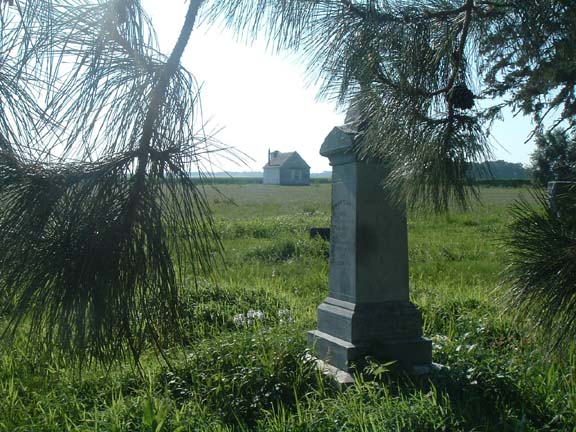
The sentinel stands straight and tall in the valley
Among them were the Timms, the Horsts and all the rest. And so another story "came together." Hopefully, the picture over the Wieseman gravesites will provide the climax.
-Dalakarl
...........................................
From the first church site visited in “the valley,” Beulah/Fairview, it is about a seven mile drive to the next one, Valley German Methodist. From there it is about another seven mile drive on to the site of Wesley Chapel just above the bluffs. A good summary of the story of that church can be found in Mildred Flodman’s Early Days in Polk County,(gray book) page 282. Compare with the later Polk County Heritage, 1975 (blue book) where more burials are listed.
There we learn that the first chapel building was a modest schoolhouse style structure “40 rods north” of the later church. Though our farmer forbears commonly used this unit of measurement to express distance it is not heard much anymore. 16.4 feet equals one rod according to Eleanor’s old math book. That means the first chapel was about a city block to the north. That would put it in the middle of a field now, but elsewhere the old books explain that not all roads ran along section lines in those days and we might surmise that this was the case here.
Prior to the building of this chapel in 1876 the group had met in a sod schoolhouse from 1872 and in homes as early as 1871. Among the pastors serving this congregation were James Query, J.J. Burley and D. Merrick. Rev. Merrick is buried in the Wesley Chapel Cemetery along the present road, where the most recent church building stood from 1903 till 1946. No structure remains since it was dismantled and donated to the Shelby Methodist church.
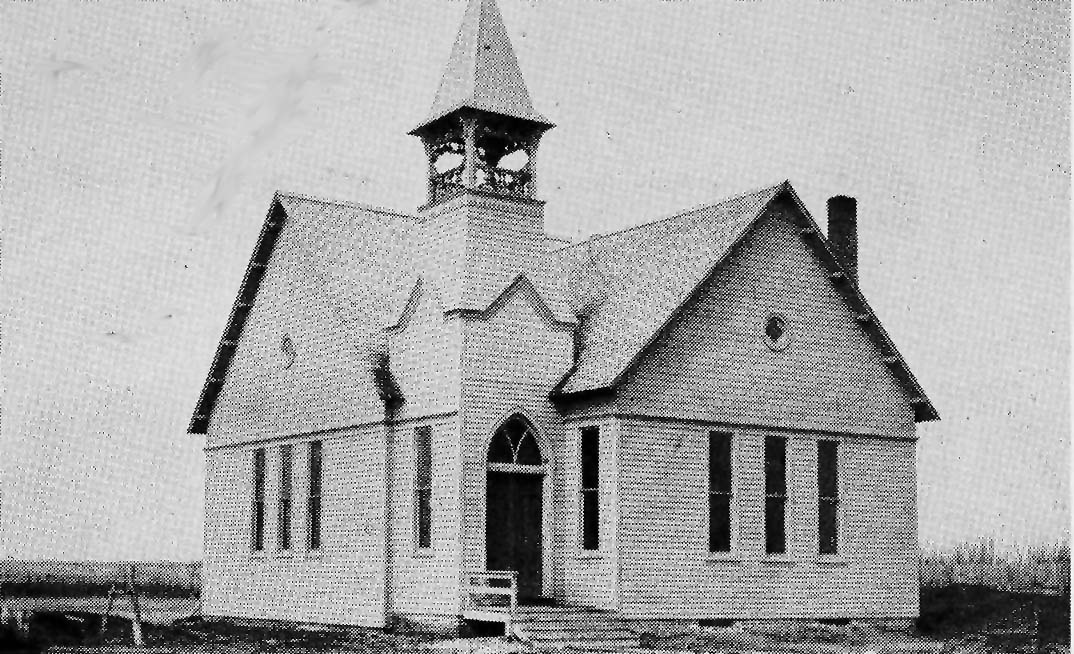
Wesley Chapel in the day

The Swearingen marker
-Dalakarl